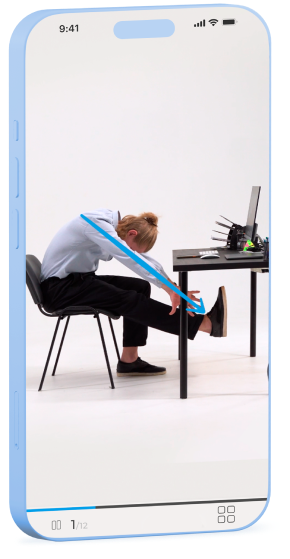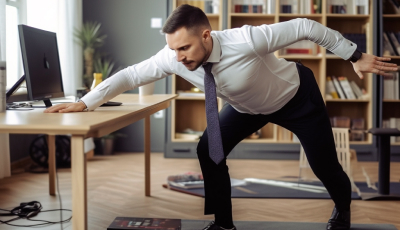Inactivity is a disease that occurs as a result of insufficient physical activity. This is a serious disease that can lead to serious consequences. The peculiarity of inactivity is that its causes can be very different, and therefore for its prevention and treatment it is necessary to have a full understanding of the causes and risk factors of this disease.
Causes of hypodynamia
One of the main reasons for the development of inactivity is a sedentary lifestyle. Most people who spend most of the day at a computer or TV do not engage in physical activity and do not fulfill daily movement norms.
Incorrect body position during sleep is also one of the reasons for the development of inactivity. If you sleep on a hard surface, on your stomach or on your side, this can lead to spinal deformity and the development of inactivity.
The reasons for the development of inactivity may be different, but some of them are more common than others. The most common causes of hypodynamia are listed below:
- Sedentary lifestyle: office work, long time spent at the computer or in front of the TV, low physical activity.
- Improper nutrition: eating a large amount of high-calorie and fatty foods that reduce gastrointestinal tone.
- Various diseases and limitations in movement: diseases of the musculoskeletal system, disorders of the cardiovascular system, pregnancy.
- Aging: Over time, muscle mass decreases, and it becomes more difficult to maintain physical activity.
- Psychological factors: stress, depression, lack of motivation

Inactivity-reduces-productivity
Risk factors of physical inactivity:
- Age of obesity,
- self-sufficient
- physical activity
- smoking
- alcohol consumption
- genetic predisposition
- prolonged sitting or standing
- posture disorders
- spine-related diseases
- obesity and hypertension.
Preventive measures:
- Physical exercise
- Selection of a healthy diet
- Weight reduction
- Smoking cessation
- Restriction of alcoholic beverages
- Maintenance of proper
Health and posture effects
Prolonged sitting can lead to a number of healthy problems, including:
- Pain in the spine
- Problems with the spine
- Osteochondrosis
- Joint diseases
- Problems with hearing and vision
- Deterioration of blood circulation
- Metabolic disorders
- Problems with the health of the cardiovascular system.
Recommendations for the prevention of diseases from a sedentary lifestyle
To prevent the development of physical inactivity and its health consequences, the following recommendations should be followed:
- To rest and move periodically
- use a comfortable and healthy chair
- to adjust the workplace correctly
- perform stretching and back exercises
- increase fluid intake
We have collected the best exercises in the "Office Health" mobile application
Together with physical therapy doctors and fitness trainers, we
prepared more
100 exercises to perform in the office. Contains exercises not only for muscles, but also
gymnastics for the eyes,
breathing practices. Detailed video instructions for the correct
execution. Invite your friends and compete.




How to prevent the development of hypodynamia
Despite the fact that physical inactivity is often a consequence of a sedentary lifestyle, there are effective methods of preventing its development. Here are some recommendations that will help improve your health and prevent the development of inactivity:
1. Regular traffic
To prevent the development of physical inactivity, it is important to engage in regular physical activity. This can be any form of physical activity, from walking in the park to working out in the gym. It is important that you choose an activity that will bring you pleasure, since you will do it regularly.
2. Workplace optimization
Another factor that can affect the development of inactivity is the way you work. If you spend most of the day at the computer, it is recommended to optimize your workplace to reduce the load on your back and chest. You can use a pillow to support your back or adjust the height of the chair, creating the correct height in relation to the table
3. Changing the body position
To prevent inactivity, it is important to periodically change the position of the body. Change the sitting position to standing, standing position to sitting, and vice versa. This will help reduce pressure on the spine and improve blood circulation. You can also try stretching or walking for a couple of minutes every half hour.
4. Improving the position during sleep
Optimizing the body position during sleep can also reduce the risk of developing inactivity. Use a pillow that supports your spine in a normal position, and sleep on a hard mattress. If you prefer to sleep on your side, make sure your knees are in line with your hips.
5. Perform stretching and flexibility exercises.
To prevent physical inactivity and improve your posture, you need to perform stretching and flexibility exercises. This may include exercises for stretching the back and legs, as well as exercises for stretching the pectoral muscles and shoulders.
6. Pay attention to your posture.
It is important to monitor your posture while sitting, standing or walking. The posture should be straight, the head is raised high, the shoulders are lowered, the stomach is stretched out and the hips are in a straight angle. If you feel that your posture is wrong, try to correct it while you are in motion or sitting.
7. Regular breaks and simple exercises
In order to reduce the risk of physical inactivity, it is necessary to take breaks every 30 minutes and perform simple exercises. Suitable exercises include simple stretches, swinging legs and relaxing the muscles of the back of the body. You can also try to do exercises to restore posture.

Coach of the highest category, doctor
info@office-health.app
Updated: 18 May 2023




















0